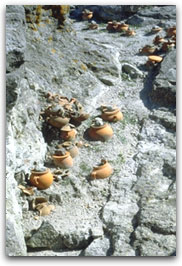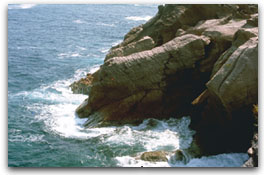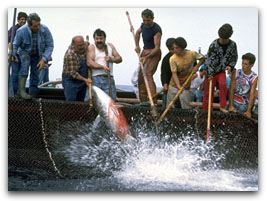Here the sea is rich in fish and
the sea bed is multicoloured. Sant' Antioco has several archaeological sites among which
there is an interesting necropolis, carved in the lee of the houses in the centre of the
village. For those who decide to stopover in the ports
of Calasetta
or Sant'Antioco a visit to the
museum "Su Binu" (which means "the wine") is well worthwhile. There is an interesting
display of the instruments used (throughout the ages) for growing grapes. In the fertile soil
of this area the 'ad alberello' vine is grown from which the famous "Sardus Pater" a
full-bodied and fragrant table wine is made. This wine is the perfect accompaniment to
any dish. From the busy port of Calasetta,
with its many fishing boats, it is possible to take a ferry to the nearby island of San Pietro.
|
|

 S.Antioco - Tophet S.Antioco - Tophet |

 Carloforte - The coast Carloforte - The coast |
|
This island, which had been
deserted, was inhabited in 1737 by people from Tabarca (near the coast of Tunis) who were
originally from Pegli in Liguria. They settled on this island to fish for coral in the sea nearby,
because coral was becoming scarce around Tabarca. They went on to found the town of
Carloforte, the only populated centre on an
island that is almost all mountains. They have always lived on fishing and many of them have
sailed the seven seas both as captains and as able seamen.
|
May in Carloforte is the tuna
season. Using ancient fishing methods, the tuna are caught and
then processed and tinned in local factories. Two tuna delicacies, the delicious "bottarga"
and "musciame" are certainly worth trying. The local food is both interesting and very tasty.
With its mixed heritage from Liguria and Africa one can enjoy typical Ligurian dishes such
as "trofiette" and "pesto" and African dishes like "cus cus" that the locals call "cascà".
The sea surrounding the island is deep and abounding in fish and it is necessary to pay
careful attention if you are sailing inshore especially in windy conditions.
|
|

 Carloforte - Tuna fishing Carloforte - Tuna fishing |
|